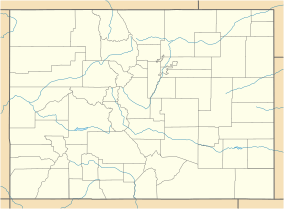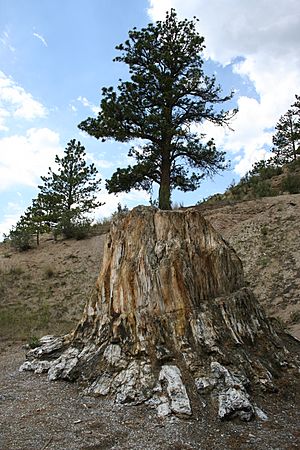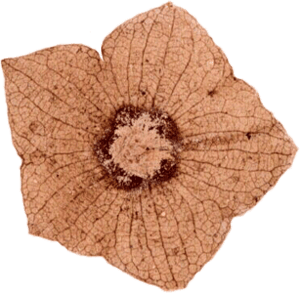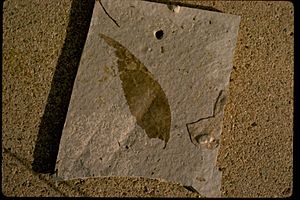Florissant Fossil Beds National Monument facts for kids
Quick facts for kids Florissant Fossil Beds National Monument |
|
|---|---|
|
IUCN Category V (Protected Landscape/Seascape)
|
|
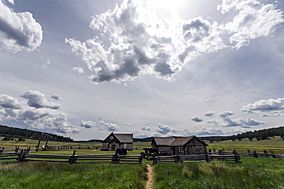
The Pioneer House, showing how the original pioneers of the west lived
|
|
| Location | Teller County, Colorado, United States |
| Nearest city | Florissant, Colorado |
| Area | 5,998 acres (24.27 km2) |
| Authorized | August 20, 1969 |
| Visitors | 71,763 (in 2017) |
| Governing body | National Park Service |
| Website | Florissant Fossil Beds National Monument |
The Florissant Fossil Beds National Monument is a special place in Teller County, Colorado. It's famous for its amazing fossils of insects and plants. These fossils are found in soft rocks called mudstones and shales, which are part of the Florissant Formation.
Scientists believe these rocks are about 34 million years old. Back then, this area was a lake. The fossils were preserved because volcanic ash from a nearby volcano mixed with tiny lake organisms called diatoms. This caused the diatoms to grow very quickly. When the diatoms died and sank, they covered dead plants and animals. This helped preserve them. Thin layers of clay, mud, and ash formed "paper shales" that hold these beautiful fossils.
Contents
History of Florissant Fossil Beds
The name Florissant comes from a French word meaning "flowering." In the late 1800s, people started visiting this area. They came to see the wildlife and collect fossils. Sadly, many early collectors took large pieces of petrified wood from the Petrified Forest. This is now a main attraction at the monument.
Geologists first mapped the area in the 1860s and 1870s. Soon after, paleontologists came to collect fossils for their research. In 1969, the Florissant Fossil Beds National Monument was officially created. This happened after a long legal discussion between local landowners and the government. Today, about 60,000 people visit the park each year. Scientists are still studying the fossils found here.
Geology: How the Land Changed
About 34 million years ago, this area was a lake surrounded by redwood trees. The oldest rock here is called Pikes Peak Granite. It's very old, from the Proterozoic era. There's a big gap in time between this granite and the next rock layer. This gap happened because of erosion during the uplift of the Rocky Mountains. This mountain-building event is called the Laramide Orogeny.
A large volcanic eruption from far away deposited a layer called the Wall Mountain Tuff. The Florissant Formation itself is made of different layers. These include shale, mudstone, and volcanic ash. The shale layers formed in the lake and are full of fossils. The mudstone layers formed in streams or from mudflows. Scientists think there might have been two different lakes over time. Mudflows could have blocked the valley, creating new lakes.
The Laramide Orogeny had been pushing up the land to the west for a long time. Then, volcanoes started erupting southwest of Florissant. These eruptions covered the area with ash and other volcanic material. This volcanic material was very important for preserving the fossils. The fossil-rich "paper shales" are mixed with thicker layers of volcanic ash.
Most of the rocks that formed after the volcanoes stopped erupting have worn away. Some younger layers contain bones of ancient mammoths. These bones are about 50,000 years old.
The Thirtynine Mile Volcanic Field
About 25-30 kilometers (15-18 miles) southwest of Florissant, there was a group of volcanoes. These were like modern volcanoes such as Mount St. Helens. This area is called the Thirtynine Mile volcanic field. These volcanoes erupted often, sending out lava flows, ash, and mudflows.
The ash from these eruptions settled over the area. The mudflows, called lahars, flowed down the valleys. This ash created the tuff layers, and the lahars formed the mudstones and conglomerates found in the Florissant Formation.
One of these lahars blocked a valley, creating a large lake. This lake could have been as big as 36 square kilometers (14 square miles). There were two main periods when lakes formed. The first lake created the lower shale layer. The second lake created the middle and upper shale layers. Over time, the volcanoes became quiet and started to erode away. Today, you can't see the volcanoes on the surface anymore.
Fossils: Windows to the Past
It's amazing that the volcanic material, which caused so much destruction, also helped preserve the fossils. As ash fell, water carried it into the lake. Mudflows also covered the bases of redwood trees. The trunks of these trees became hard and fossilized. This process is called permineralization. Minerals from groundwater flowed through the tree trunks, replacing the wood with silica. This turned the tree stumps into stone.
Inside the lake, volcanic material was regularly deposited. This material was rich in silica. Tiny organisms called diatoms, which have silica shells, lived in the lake. The extra silica caused the diatoms to grow rapidly, creating "blooms." At the same time, the volcanic activity caused many plants and animals to die. As they died, their leaves and bodies fell to the bottom of the lake.
This process happened often, maybe even every year. The diatom blooms and die-offs created thin layers of ash and clay. These layers were pressed down to form "paper shales," which are usually less than a millimeter thick. These paper shales hold the best-preserved fossils. Scientists estimate the lake might have lasted for 2,500 to 5,000 years, based on these yearly layers.
Paleoflora: Ancient Plants
The Florissant Formation has a huge variety of plant fossils. These range from giant redwoods to tiny pollen grains. The Petrified Forest is a major attraction. About 30 petrified stumps are preserved there. They are some of the largest petrified stumps in the world. Most of them are similar to modern sequoias, or redwoods. These trees could have been as tall as 60 meters (198 feet). They likely died when mudflows cut off oxygen to their roots. By studying their tree rings, scientists think some trees were 500–700 years old when they died. Some stumps are from flowering plants (angiosperms).
The Florissant Formation is also known for its fossilized leaves. You can also find fossilized fruits, seeds, cones, and flowers. Most of the leaves come from trees and shrubs. Flowering plants are the most common plant fossils, but conifers are also present.
Fossilized sequoia cones, leaves, and pollen have been found. They are a bit different from modern California redwoods. The fossil leaves are thinner, and the female cones are smaller. More than 130 types of pollen have been found in the shale beds. These show that many different plant habitats existed around the lake.
Tiny diatoms are common in the beds. Their silica shells fossilize easily. When volcanic ash added silica to the lake, diatoms bloomed. These blooms helped preserve other fossils. Florissant is important because it shows some of the earliest known freshwater diatoms. About 50 million years ago, the first roses in the Americas grew here.
Fauna: Ancient Animals
Most of the animal fossils at Florissant are invertebrates (animals without backbones). But many vertebrates (animals with backbones) have also been found. The large number of species shows that the environment was perfect for many different animals. The excellent preservation of these animals helps us understand their ancient home and even some of their behaviors.
Invertebrates: Insects and Spiders
The invertebrate fossils include arthropods like spiders, millipedes, insects, and ostracods. Also found are mollusks like clams and snails. Spiders and insects are the most important, with over 1,500 species identified.
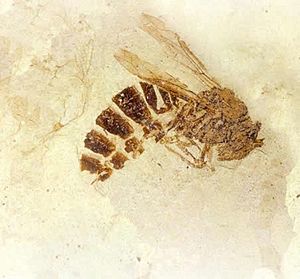
Many types of Arachnids are found, mostly spiders. There are also possible examples of harvestmen and daddy long-legs. Scientists have not yet found full body fossils of gall mites. One interesting thing about the fossil spiders is that their legs are often stretched out. This might mean they died in warm or acidic water.
The insects found in the ash-clay beds are very diverse and numerous. These include mayflies, dragonflies, damselflies, grasshoppers, crickets, katydids, cockroaches, termites, earwigs, web-spinners, cicadas, snake flies, lacewings, beetles, flies, mosquitoes, butterflies, moths, wasps, bees, and ants. Beetles are the most common, making up about 38% of all insect fossils. These fossils include both water and land insects. They give us clues about the ancient environment.
Ostracods probably ate algae at the bottom of the lake. Most ostracod fossils are their shells or feeding parts. Only one species of ostracod has been described so far. Several freshwater mollusks have been found. The most common mollusk is the gastropod (snail).
Vertebrates: Fish, Birds, and Mammals
Vertebrate fossils at Florissant are mostly small pieces of bone. A few species have been identified, mainly fish, but also some birds and mammals.
Fish found here include bowfins, suckers, catfishes, and pirate perches. Most of these fish lived at the bottom of the lake. Many could live in poor water conditions. Most fish fossils are found in certain shale layers. This might mean that conditions were better for fish at different times in the lake's history.
Three types of birds have been found, including a cuckoo. Most of the skeleton was missing, but enough was left to identify the bird. There are also examples of rollers and shorebirds. Other birds were mentioned in old writings from the 1800s. But we don't have enough information to identify them today.
Mammal fossils are very rare in the shales. Only one small opossum fossil has been found there. In the lower mudstone layers, broken bones of a horse, a brontothere, and an oreodont have been found. The horse would have been small, about the size of a medium dog. It had three toes on each foot. This information comes from a complete lower jaw. The largest mammal found is a brontothere. This was an elephant-sized animal with thick horns on its head. This information comes from bone fragments and tooth pieces. The oreodont was an extinct animal that looked like a modern sheep or pig. Only a jaw fragment of an oreodont has been found. Other mammals have been identified from tooth fossils. In total, about a dozen different mammal types have been found at Florissant.
Surprisingly, no reptiles or amphibians have been found at Florissant. This is unexpected, as they should have been there. Scientists don't have an explanation for this, even with nearly 40,000 specimens in museums. Toxic water from volcanic activity could be a reason, but other aquatic animals lived in the lake.
Paleoclimate: What the Weather Was Like
Fossil plants, especially their leaves, tell us a lot about the climate when the Florissant Formation was forming. Plants are more sensitive to climate changes than animals. Animals can move to find better conditions.
By comparing fossil plants to modern ones, scientists can guess what the climate was like. One good way is to study the features of the fossil leaves. By looking at their general appearance, scientists estimate the average temperature was around 13 °C (55 °F). This is much warmer than Florissant's modern average of 4 °C (39 °F). Some estimates suggest it was even warmer, between 16-18 °C (61-64 °F). This is based on comparing them to their closest living plant relatives.
The fossil plants also suggest that seasonal changes were not as big as they are today. Estimates based on pollen suggest temperatures as high as 17.5 °C (63.5 °F). However, leaves are often more accurate than pollen for climate studies.
Based on the size and features of fossil teeth, the rainfall was about 50-80 centimeters (20-31 inches) per year. There was also a clear dry season. This is much wetter than the modern average of 38 centimeters (15 inches) of rain. Most rain would have fallen in late spring to early summer. Snowfall in winter would have been rare.
Tree-ring analysis of the redwoods shows that their environment was even better than where redwoods grow in California today. The average width of a tree ring (one year of growth) is larger than in modern California redwoods. Towards the end of the Eocene period, the global temperature started to drop. However, the fossils at Florissant don't show this global cooling trend.
Paleohabitats: Ancient Homes
The fossilized algae and water plants show that the lake was shallow and had fresh water. Near the streams and shore, there was plenty of moisture. This allowed lush plants to grow. However, further up the hillsides, the plants were more adapted to dry conditions. At the bottom of the valley, large trees like sequoias dominated the landscape. Smaller trees and shrubs grew beneath them. There was a gradual change in habitats from the valley floor up the hillsides.
Insects from the area also show different habitats. Some insects, like dragonflies, lived only in or near the lake. Bees and butterflies, on the other hand, preferred the open spaces in the surrounding hills and meadows.
Paleoaltitude: How High Was It?
Early guesses about Florissant's elevation were between 300–900 meters (980-2,950 feet). This is much lower than its modern elevation of 2,500-2,600 meters (8,200-8,500 feet). However, newer estimates, based on fossil plants, suggest the elevation in the Eocene was much higher. Some ideas range from 1,900 to 4,100 meters (6,200-13,500 feet). This would mean that global climate change, not just land uplift, caused the environmental changes here.
The exact elevation of the Florissant area during the Eocene is still being studied. While most plant fossil analysis suggests a higher elevation than today, some evidence points to a lower elevation, similar to earlier estimates.
|


